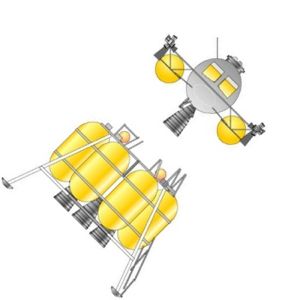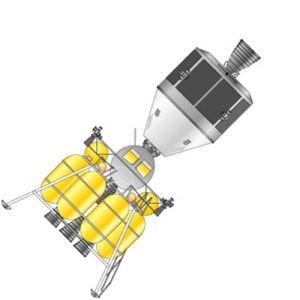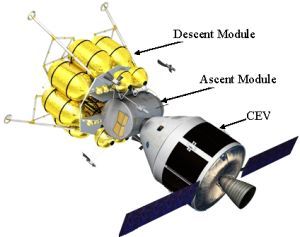LSAM (original) (raw)

Home - Search - Browse - Alphabetic Index: 0- 1- 2- 3- 4- 5- 6- 7- 8- 9
A- B- C- D- E- F- G- H- I- J- K- L- M- N- O- P- Q- R- S- T- U- V- W- X- Y- Z
LSAM

CEV
CEV and NASA Lunar Lander, late 2005
Credit: © Mark Wade
American manned lunar lander. Lunar lander proposed by NASA in 2005 for their planned return to the moon by 2018.
AKA: Altair;LSSM;Lunar Surface Access Module. Status: Study 2005. Thrust: 66.60 kN (14,972 lbf). Gross mass: 32,600 kg (71,800 lb). Specific impulse: 362 s. Height: 9.90 m (32.40 ft). Diameter: 7.60 m (24.90 ft). Span: 9.50 m (31.10 ft).
The Block 2 baseline lunar scenario involved the placing in an earth parking orbit by a shuttle-derived heavy-lift Cargo Launch Vehicle of a trans-lunar injection (TLI) stage and an unmanned Lunar Surface Access Module (LSAM). Within 30 days, a Crew Launch Vehicle (CLV) would launch a manned CEV into orbit. The CEV would rendezvous and dock with the LSAM and TLI stage. The combined spacecraft would be put on a trans-lunar trajectory by the TLI stage, which would then be jettisoned. The LSAM would brake the combined CEV and LSAM spacecraft into lunar orbit. The four-man crew would transfer to the LSAM and descend to the surface, leaving the CEV in unmanned quiescent mode in lunar orbit. Initial missions would come only twice a year, with a two week stay time on the surface. Later missions might last for up to nine months.
When the LSAM's crew was ready to leave the moon, they would fire the LSAM ascent stage, and then rendezvous and dock with the unmanned CEV. The LSAM ascent stage would be cast away, and the CEV would perform the trans-earth injection maneuver, and then take the crew to a return to earth at Edwards Air Force Base.
The LSAM was a two-stage vehicle. The first, descent stage, was powered by two throttleable RL10-derived engines burning liquid oxygen and hydrogen. This stage would brake the CEV/LSAM in lunar orbit, accomplish any needed trajectory adjustments, and then land the crew on the surface. The stage was provided 1,100 m/s delta V for the lunar orbit insertion and 1,850 m/sec delta-V for lunar descent.
The LSAM ascent stage would be equipped with an integrated pressure-fed propulsion system consisting of one 66.7-kN OMS main engine and twenty-four 445-N RCS thrusters. These engines would be common to the CEV Service Module. The fuel tanks would be Al-Li graphite wrapped, rated at 22.1 atmospheres, and use gaseous helium pressurant. NASA decided to use the new liquid oxygen/methane propellant combination to gain experience with the combination. Methane could be generated from the Martian atmosphere to provide rocket fuel for future Mars expeditions. By using the same engines on the CEV SM, they would be well tested and have substantial flight experience in CEV missions to the ISS before any moon mission was attempted.
NASA claims the LSAM would had the capability for Global Lunar Access" and "Anytime Return" despite the use of the lunar orbit rendezvous mission scenario. But it would be the CEV that would be required to make any lunar orbit contingency plane changes needed prior to ascent of the LSAM (evidently about 300 m/s of delta-V was allocated to the CEV for this purpose).
Calculations based on NASA statements indicate there was substantial margin in the design. Preliminary calculations indicate the following breakdown for a manned lunar landing mission:
- Total LSAM mass: 32,600 kg.
- Descent stage: 19 metric tons of propellants
- Mass of equipment, shelters, supplies used or left behind on lunar surface: 2700 kg For an unmanned lunar base or resupply mission without the CEV, the breakdown would be as follows:
- Total LSAM mass: 54,600 kg.
- Descent stage: 33,600 kg; empty mass 7,400 kg
- Mass of equipment, shelter, supplies used or left behind on lunar surface: 21,000 kg
The cylindrical crew quarters would include an airlock to segregate dirty spacesuits and other equipment from the living area. Part of the quarters may be left behind on the surface for use by future expeditions. Equipment on the first missions would include individual lunar rovers for each of the four crew members. These rovers would allow teams of two to four crew to travel up to 20 km from the landing site on daily sorties. A minimum team of two would allow return to base even if one rover broke down.
NASA foresaw the new lunar missions concentrating not so much on the traditional lunar science subjects, but rather on the search for water and other resources on the moon that could be used to refuel spacecraft, and testing of technology and equipment for future Mars expeditions.
Crew Size: 4. Orbital Storage: 180 days. RCS Coarse No x Thrust: 24 x 440 N. RCS specific impulse: 315 sec. Spacecraft delta v: 4,800 m/s (15,700 ft/sec).
More at: LSAM.
Family: Moon. Country: USA. Launch Vehicles: Ares V. Propellants: Lox/LCH4. Agency: NASA. Bibliography: 6657.
Photo Gallery
 |
CEVCEV and NASA Lunar Lander, late 2005Credit: © Mark Wade |
|---|
 |
CEVCEV and LanderCredit: NASA |
|---|
Home - Search - Browse - Alphabetic Index: 0- 1- 2- 3- 4- 5- 6- 7- 8- 9
A- B- C- D- E- F- G- H- I- J- K- L- M- N- O- P- Q- R- S- T- U- V- W- X- Y- Z
© 1997-2019 Mark Wade - Contact
© / Conditions for Use